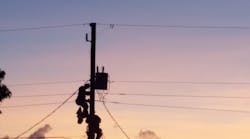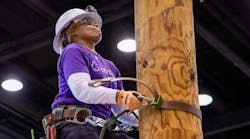After high winds and heavy rain in Texas and Florida, contract linemen swiftly came to the rescue of impacted utilities. T&D World visited with one of the contractors who responded, UtiliCon Solutions, about tools that were used, travel arrangements and community response.
Q: Which utilities called upon your company for assistance? In turn, did you contact your linemen by cell phone, text, or email, and how much time did they have to prepare before getting on the road?
First, here’s a little background on UtiliCon Solutions, LLC, an Asplundh company. UtiliCon Solutions is a holding company for the following separate subsidiary companies, who responded to Hurricanes Harvey and Irma: Utility Lines Construction Services, Musgrove Construction, Asplundh Construction, American Lighting and Signalization, Grid One Solutions, and American Electrical Testing.
UtiliCon constantly tracks severe weather with the potential to require resources beyond the affected area’s existing resources. Director of Project Management John McNamee coordinates the efforts of numerous field and administrative managers, as well as top-level executives, on our Storm Team. Their primary goal is to safely and efficiently help our utility customers restore power and services. All of UtiliCon’s subsidiaries supported recent storm restoration activities, which ranged from storm damage assessment to rebuilding distribution circuits, transmission lines or traffic signal systems.
HARVEY
We watched tropical storm Harvey as early as Aug. 18, but were not concerned until Tuesday, Aug. 22, and Wednesday, Aug. 23 when the tropical depression reformed in the Gulf. We began preparations for the evolving threat approximately three days before it made landfall as a Cat 4 near Rockport, Texas, on Aug. 25, at 10 p.m.
On Aug. 23 and 24, we were in touch with our existing utility customer base and reached out to others in TX and LA, providing them with updates on our resource availability. After Harvey’s damaging winds dissipated, the damage became apparent, but the flooding made access extremely difficult. Once the area around southeastern TX was safely accessible, we moved our Utility Lines Construction Services resources in to support transmission line restoration.
IRMA
For Hurricane Irma, we received numerous requests for storm restoration assistance from investor-owned utilities and various muni’s and co-ops in TN, NC, SC, AL, GA, and FL. In addition to our local crews who were already preparing for storm work, we mobilized additional resources from our operations in the Northeast and Midwest to support 14 storm-affected utilities operating in all of those states mentioned above.
We began tracking Irma in the Atlantic around Labor Day weekend, Sept.1-4, before it impacted the Leeward Islands. On 9/5 we updated our resource summaries and reached out to our existing customers to establish our communication protocols and to compare notes on the storm. We were also in touch with other utilities in TN, NC, SC, AL, GA, and FL, providing them with updates on our resource availability. On Wed 9/6 utility requests became firm and crews started traveling to pre-staging areas.
Typically, once our crews get the word via phone or text that they are needed in a storm-affected area, they quickly make sure their family is OK, get a bag packed, collect personal items, check their truck for a long trip, and are on the road in under a couple hours. They have a sense of service and take pride in getting the lights back on for folks in need.
Irma made landfall Sunday 9/10 as a Cat 4 in Cudjoe Key at 9 a.m. and Marco Island at 3:35 p.m.
Ultimately, UtiliCon Solutions deployed resources for approximately two weeks to serve over 14 companies in storm restoration.
Q: What are some essential tools and equipment that the crews stocked on their truck when heading out on the storm restoration?
In addition to the normal complement of overhead distribution line tooling and equipment (digger derrick line trucks, bucket trucks, pickup trucks), we worked with our customers in advance to get a sense of the anticipated damage and coordinate any specialized equipment needs such as storm field office trailers, tracked vehicles, boats, pole trailers, or rear property machines. Additionally, our personnel were prepared for some rough living conditions on the first couple days of the storm response. Our crews were pre-staging in TN, AL, GA, and even north central Florida. They were advised to bring or acquire water, non-perishable food, sunscreen, insect repellent, batteries and all the fuel they safely could before they got to central Georgia, based upon shortages of these items that were reported on our daily storm call updates. An evacuation order for an estimated 6.3 million Floridians, coupled with more than 50,000 vehicles coming into the Southeast to pre-stage for storm response, put a strain on interstates and area resources all across the Florida-Georgia border.
Q: How many of your linemen did you send, and how did you decide who to send? Where did you send them to (which staging site)?
We had over 1,400 UtiliCon personnel supporting Hurricane Irma restoration.
Our Storm Team gathers information on available crews from our management regions across the country and generates resource summaries. Then they coordinate the allocation of those resources to existing utility customers, new customers, and Mutual Assistance.
Many of our personnel were initially assigned to report to receiving centers in South Georgia and North Florida and then re-deployed further south after the Irma weather threat had passed.
Q: Talk about the convoy of crews. Do they all travel together, and if so, how does that feel for them to be out on the road as a team?
We don’t always convoy. We focus on getting to our assigned location safely. That means ensuring good vehicle condition, driver focus and alertness, and applying our safe driving training techniques with particular attention to speeds and following distances. It also means mobile communications and using our telematics fleet tracking tools to provide constant updates on our mobilization status.
During storms, we encounter additional hazards such as intersections with no signalization in operation, road debris and washouts, an increased volume of drivers at times, and other drivers that are emotionally charged and not thinking straight. We remind our crews to be on alert and patient with others. Storm response is a high profile opportunity to demonstrate our safety, professionalism, skills, and values in helping others. We focus on that mission. In our business, there is no better feeling then safely getting lights back on.
Q: What were the conditions like when the crews arrived at the storm restoration zones in Florida and Texas? Talk about the damage and destruction. How would they describe it? Was it like another storm your crews have worked on?
We received initial reports that the transmission systems held up pretty well. That’s good design, good maintenance, and a little bit of luck since Mother Nature always has the last word. We had reports of distribution feeders off and wires down, but the pole damage was limited. This was very similar to other storms we have worked on with two notable exceptions; 1) the scale of Irma impacted a six-state area and we were working in seven states when you count that we still had resources on storm duty for Hurricane Harvey in TX and, 2) the increasing level of public expectation for speed in restoration.
Q: How do your crews stay safe when working around floodwater? Do they have special protective equipment or work practices? How did they deal with the high amount of mosquitos and hot weather conditions?
Our transmission and distribution crews in the South are accustomed to working in wet environments in coastal locations. We just don’t normally see those conditions inland. Fortunately, we have marsh equipment and PPE for working adjacent to and in water.
Q: Who is the host utility you are working for, and what kind of training do your crews receive on site? What about safety briefings? What is covered in these, and how often are they?
Our utility customers provided excellent initial gateway briefings.
These were important to demonstrate their host utility leadership and organization, set a professional tone, reaffirm safety and professional expectations and establish solid communications. They gave briefings on system voltages and Arc Ratings, as well as any unique construction or known equipment hazards, and provided reference information on sectionalizing/fusing, Lockout/Tagout procedures, Work Management, Facility Records and Maps, Field Coordinator Communications, Materials/Waste/Environmental Management, Environmentally Hazardous Plants/Animals/Insects, Housing, Emergency Plan, etc.
This briefing is an important transition point from mobilization to safe restoration. It’s also a valuable pause after traveling to get workers’ minds focused on safe restoration.
Our leadership provided our teams with daily safety briefs, safety bulletins, and Irma event updates. Our teams performed safety checks in the yard/staging area and then performed Job Hazard Assessment and Job Briefs on-site.
An example of a safety bulletin would be a discussion of Roadway Hazards. Coincidentally, right after we talked about Environmentally Hazardous Plants/Animals/Insects indigenous to Florida, one of our crews reported an eyeball encounter with a panther. Thankfully, no harm done to either party!
Q: What kind of work are they responsible for as part of the storm restoration team? What are their work days like, and how long are they? Do they work in shifts?
We had teams performing damage assessment and putting primary and secondary distribution lines back up. Our transmission crews were lending a hand to supplement our distribution crews and provide assistance on some concrete pole jobs. Testing technicians helped to make sure damaged substation equipment was safe and ready to be reenergized. We also had crews working with Florida DOT to lower high-mast light fixtures before the storm and restore damaged traffic systems.
It was a 24-hour work day with overlapping 16-hour work and 8-hour rest shifts.
Q: Where are the crews sleeping, and how are the meals arranged?
Utilities provided a variety of hotels, modular trailers, and food tents. Our crews experienced everything from three-star hotels to sleeping in their trucks until things could get sorted out. The first three days had challenges, but we applaud our teams for their patience and feedback, and the host utilities for making improvements.
Q: How is the local community responding to the efforts of your line crews? Have you gotten any special thank you's?
We witnessed a broad spectrum of responses from members of the local communities we served. Some just urgently wanted their lights back on yesterday. Others recognized that our crews were away from home and working diligently and safely to get the lights back on as fast as possible. It only took a small thank you to recharge the batteries of crews who were working 16 hours a day.
It’s reinforcing when a senior utility manager you’re working for tells you he is not happy with the crews’ sleeping or meal accommodations that the utility was providing on the first couple days, apologizes for it, and vows to do something about it. Those human touches go a long way.
12. How do you feel about being part of the largest restoration workforce in U.S. history?
UtiliCon Solutions is very proud of our family of subsidiary companies and our employees. We are also proud to be part of an extended industry team. We are fortunate to be able to serve.


